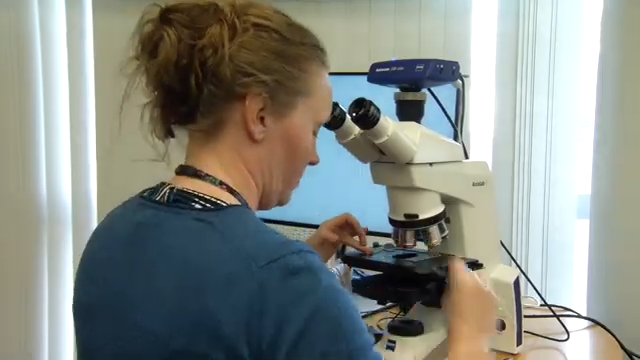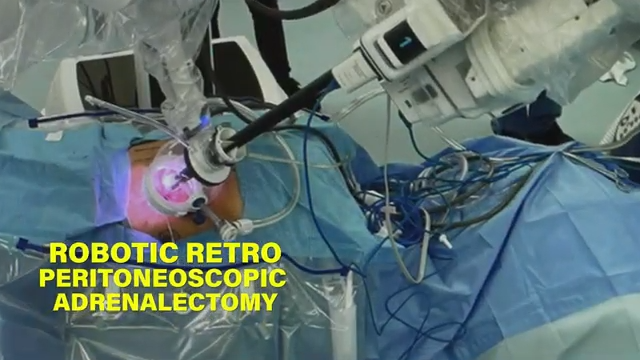COLUMBUS, Ohio (Ivanhoe Newswire) – Sixteen million American adults have chronic back pain and every year, surgeons perform more than one and a half million spine surgeries in an effort to bring some relief. Now, a high-tech guidance system allows surgeons to be more precise and efficient during back procedures.
Forty-seven-year-old Jennifer Minnear can stand tall without pain for the first time in 27 years – that’s when she fell down a flight of stairs, carrying her six-month-old baby.
“I just took the brunt of the injury. Fell flat on my back on the stairs,” Minnear recalls.
Minnear’s daughter Rosemary was unharmed, but Minnear injured her spine and her neck, starting years of chronic pain.
“I could be walking and all of a sudden, it just grabs hold of me,” Minnear emphasizes.
Since 1999, Minnear has had five spine surgeries. But for the most recent, Safdar Khan, MD, orthopedic surgeon at the Ohio State Wexner Medical Center, had new technology guiding him – the Augmedics X-Vision Spine System.
Doctors can simultaneously see a computer-generated image of the patient’s spine, while looking at the patient on the operating table.
“I can plan out a better surgery because I can see the patient’s anatomy, even before making an incision,” Dr. Khan mentions.
In traditional spine surgeries, doctors refer to x-rays projected on a screen across from the patient.
Dr. Khan explains, “In order to place the instrumentation, the surgeon has to look down in real time and then, look up, and then, look down.”
With augmented reality headsets, surgeons don’t take their eyes off the patient.
Minnear says she felt better as soon as she woke up from surgery.
“I’ve never had a recovery like this. Never,” she expresses.
It’s the best her back has felt in more than two decades.
Dr. Khan says because he is operating in a more efficient manner with smaller incisions and a more targeted approach, the length of surgery has decreased, which means patients are exposed to less anesthesia. Dr. Khan was among the first surgeons in the United States to use the system.
Contributors to this news report include: Cyndy McGrath, Producer; Kirk Manson, Videographer; Roque Correa, Editor.
To receive a free weekly e-mail on medical breakthroughs from Ivanhoe, sign up at: http://www.ivanhoe.com/ftk
Sources:
https://hpi.georgetown.edu/backpain/
MEDICAL BREAKTHROUGHS
RESEARCH SUMMARY
TOPIC: AUGMENTED REALITY FOR BETTER SPINE SURGERY
REPORT: MB #5085
BACKGROUND: AR, or augmented reality, is defined as a computer-generated image on a user’s view of the real world. In medicine, this allows surgeons to attain an enhanced view of natural environments or situations with information that is not seen normally with the naked eye. Many surgeons are now using AR to improve patient outcomes by increasing spinal instrumentation placement, so surgeons know what to do with each patient. Wearing the AR headset is crucial as it helps create computer generated images of CT scans into the eyepieces of the headset displaying information over the physical reality of the procedure.
DIAGNOSING: About eight out of 10 people will experience debilitating back pain during their lifetime. For some people, medication and lifestyle changes won’t be enough to help relieve the pain and surgery is the only option. About 1.6 million people in the U.S. have some form of spinal surgery to help alleviate pain in which 60-70% of patients report less pain after the surgery. The technology is a headset with “see-through” eye technology that displays the images of the patient’s internal anatomy such as bones and tissues as this is very similar to a CT scan and it gives the surgeon x-ray vision.
NEW TECHNOLOGY: The technology is similar to a real-time GPS system. It uses ‘see-through’ technology to help the surgeon know where to exactly place implants and helps bring a personalization and care to the operating room. It also uses an image guidance system to help keep the surgeon’s focus directly on the patient rather than a screen or monitor that has an x-ray.
(Source: https://www.coloradoback.com/blog/augmented-reality-spine-surgery)
FOR MORE INFORMATION ON THIS REPORT, PLEASE CONTACT:
Serena Smith
(614) 893-0370
If this story or any other Ivanhoe story has impacted your life or prompted you or someone you know to seek or change treatments, please let us know by contacting Marjorie Bekaert Thomas at mthomas@ivanhoe.com




